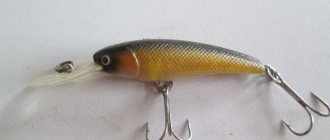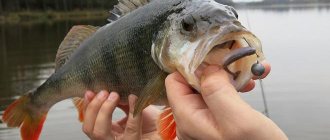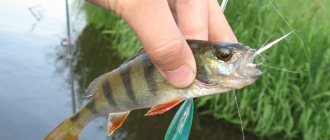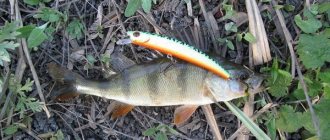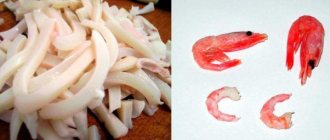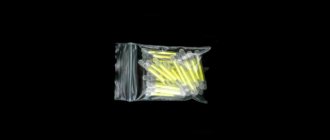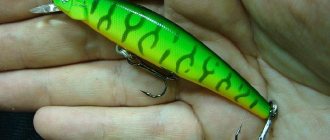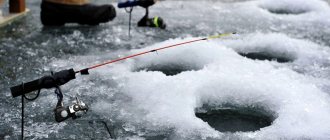Microjig fishing in cold autumn water. Recommendations for choosing bait, loading it and wiring techniques. Features of catching the most common predators.
With the onset of autumn, microjig does not lose ground, although its effectiveness decreases. This is largely due to the general movement of fish to depth, where it is more effective to catch them with more powerful gear with large bait. But, thanks to its filigree, the microjig continues to effectively catch fish even in pre-winter conditions, and it’s quite possible to comb the outback with a four-gram eared fish. However, the approach to fishing is significantly different.
Well, let's begin. What is the difference?
What’s different is that the air temperature drops lower and lower every day. The water cools down every day, and by the end of autumn it becomes 5-8 degrees. Fish are cold-blooded and their body temperature is approximately equal to the temperature of the water. Consequently, all processes in the body can be said to be suspended, which means that the fish becomes passive and inhibited.
We select the key. What does a passive fish want? It is quite logical - a passive bait, carried out in a passive style.
Tackle for catching pike perch with jig
An indispensable tackle when catching pike perch in the fall with a jig is a spinning rod. Its length is selected in the range from two to three meters. If you are fishing for pike perch from a boat, you can use shorter gear (up to two meters). For more obvious control over the behavior of the jig during retrieving, you need a fast-action spinning rod, that is, one in which the upper third of the blank bends under load.
It is better to choose a fishing line for autumn fishing for pike perch with a jig in the range from 0.14 to 0.2. Braid is ideal as it has a much lower stretch coefficient.
A larger line diameter is ideal if you are fishing in areas that have snags in the water. It will allow you to easily unbend it when hooking the bait hook.
When hooking or retrieving, pike perch usually behave pliantly. Only large individuals show active resistance when fishing. Don’t listen to those who claim that they are great at catching pike perch using monofilament fishing line. He may be able to catch fish, but he simply doesn’t hear most of the bites, and if he does hear them, then due to the stretchability of the monofilament line, he simply doesn’t have time to hook.
I will say the following about the diameter of the braid: thick fishing line sails more in the water and requires heavier jigs, reels and spinning rods. For fishing on level ground, without hooks, one that can withstand a weight of 10 kg is enough. The use of a more powerful fishing line on Central Russian rivers is hardly justified, except for catching catfish. Personally, I fish with a Power Pro with a diameter of 0.15 mm with a stated load of 9 kg, a Twin Power 3000 F reel and am very pleased with them.
And now a little trick that will be very useful and will help any novice angler for whom catching pike perch with a jig in the fall has become a dream. Let’s say that we have found the location of a pike perch, but the bite is sluggish, the fish is capricious when biting. The pike perch either begins to hit the sinker, then presses the bait to the bottom and still fails to hook it.
In this case, using miniature baits will be very helpful for catching pike perch with a jig. Even the most lethargic and sleepy pike perch, when a small bait falls in front of its nose, will certainly try to grab it. Of course, the small size of the bait does not cause problems for the predator when swallowing it. Well, hooking and fishing here directly depend on the fisherman himself and his skill.
Loading
The load is selected as follows. The bait is loaded with the weight that will propel it during the fall. After simple manipulations with lowering the bait to the bottom (the bait is lowered on a stretched line), we begin to reduce the load. At the next load, our bait stops working, so the previous load is the one we need. For example, the two-inch Kopito from Relax works best with a weight of 2.4 grams. That is, 2 grams does not really turn it on, but at three grams the bait falls quite quickly. Take this technique into your arsenal and see how much the number of bites will increase.
Types of equipment in microjig
Ten years ago, the overwhelming majority of fishermen used jig heads, but today they have been replaced by collapsible sinkers called “Cheburashkas”. Their advantage lies in the flexibility of installation, since the hook is attached to the load on a hinged basis. In addition, the spinning angler can change the hook at any time, leaving the weight of the sinker suitable for the fishing conditions.
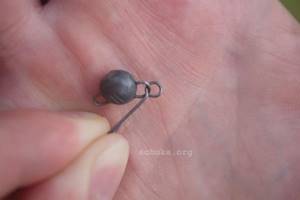
The most popular types of equipment:
1. Drop shot. This installation is a tightly fixed oval-type sinker, which is tied directly to the end of the cord. Above the load there is a locked hook with bait. The advantages of installation include the natural play of the bait and the absence of resistance from the load when biting. Thus, the predator swallows the bait without feeling the weight of the lead underneath. This model works great when fishing for passive perch and pike perch.
2. Texas rig. This type of installation differs from the previous one in the placement of elements. In this case, the hook with bait is at the end, and the sinker is higher up the cord. I would like to draw your attention to the fact that the lead used is sliding, so that when reeling in, it comes together with the bait, and when it falls, it separates from it. This model is perfect for conditions where long-distance casting is necessary, since the installation forms one whole during flight. Another advantage is considered to be its rare tangling, in contrast to spaced rigs, where the bait is located at a distance from the sinker.
3. Carolina rig. It differs slightly from its analogue. To install it, you will need all the same elements, however, with a small addition in the form of a swivel. The essence of the equipment is that the bait is mounted on a leash, which, in turn, is attached to a swivel. Thus, the Carolina rig is something between a drop shot and a Texas rig.
Another popular equipment in microjigging is a retractable leash. It is more common among our fishermen and is a familiar rig for spinning anglers. A retractable leash is used when the fish is very passive, as well as in cases where it is necessary to hold a miniature bait at a considerable depth.
Microjig lures
About bait sizes
Autumn, the predator is inactive. Every movement, every throw requires energy. It is quite logical to assume that it is more profitable for the same perch to catch up and eat the fry than to collect small insects all day. As fishing shows, there are more bites on a two-inch twister than on an inch-sized twister, and Volodya Shcherbakov’s favorite saying, “The mouth rejoices in a big piece,” is very appropriate here.
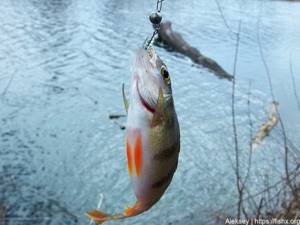
About the color of the bait
Experience accumulated over several years shows that at a certain period, for some reason, baits of a certain color work better. At the end of autumn, lures in the color of the fry work better, but twisters of popular sports colors (acid baits, etc.) lose in the number of bites.
Fishing technique
Fishing for pike with a jig has its own characteristics depending on the conditions: the chosen location, weather conditions, the presence of food supply for the predator in the reservoir, the nature of the bottom, the presence of natural shelters for the predator, and many other factors.
All autumn pike fishing is divided into two periods:
- early autumn, during which there is still aquatic and bottom vegetation on the reservoir (September and October, its first half);
- late, when the plants lay down, the water becomes clear and its temperature drops (November).
About
Pike
Catching pike with a microjig during the period under review is hardly advisable. Haika prefers large prey, and only a small grass fish, the size of which will be slightly larger than the size of the bait, will covet a small twister. A medium category jig with twisters from 8 centimeters would be appropriate here. And the depths of the autumn haika habitat will clearly not be microjigs.

What kind of fish is caught in the fall using microjig?
The main types of fish that are caught with microjig in the fall: perch, pike, pike perch. These types of fish can be caught with occasional success almost all year round using stepwise fishing. Moreover, there are often periods when large, predatory fish feed on small animal organisms. These periods are evenly distributed throughout the year. So you can catch large fish using a microjig at any time of the year. This is especially true in the autumn. In the fall, predatory fish choose large victims, trying to gain more fat for the winter. But for some reason that only she understands, the predatory fish always attacks the silicone bait on a small jig head.
With a decrease in water temperature, at the beginning of autumn, many peaceful fish species switch to a predatory lifestyle. These types include:
- carp;
- crucian carp;
- ide;
- rudd;
- roach;
- bream.
All these fish species are not uncommon catches in catches using small bottom baits. Especially in deltas of large rivers such as the Volga, Don and other large rivers.
Gear selection
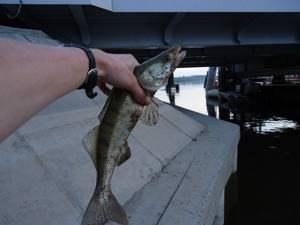
Based on this, the choice of kit(s) should be approached very, very responsibly - night fishing does not forgive mistakes. And if during the day we can see shoals coming out on a reel or stick, loops on the cord, abrasions, then at night constantly lighting a headlamp means scaring away all the pike perch in an area of 50 meters.
All that is required from a reel, and I want to start with it, is smooth running, excellent laying and an excellent working clutch. Leave props like cork knobs on the handle, holes in the body or patterns on the spool for fishing during the day; at night, technical characteristics come to the fore. The size is no less than 2004 according to the dive, let the thousands of people sleep on a shelf at home. Night is the time for monsters to party, and instead of a 5 kg pike perch, theoretically, and often practically, our bait is grabbed by catfish, the size of which can exceed the weight of the fisherman. Now the situation is - you are standing knee-deep or waist-deep in the river, catching a pike perch, suddenly there is a blow and a hook that begins to wander. What do you do with a reel that picks up only 40 to 50 cm of cord in one turn? That's right, you will salt the fish that will come at you. Yes, and it is undesirable to force a small mechanism with loads - it gets caught here, you need to tear it out, then force pumping out there, or something else... I remember, at the very beginning of my night-time pike-perch career, I used an old but reliable Zauber from Ryobi 2500 size. The coil then lived for only six months, and died in October. And it was an old, gray Sauber from Japan, still in a plastic case, not on the infinity, essentially a Soviet tractor. But it couldn’t withstand the loads and crumbled. And this was in 2006, when on the Oka it was possible to surprise only people who were not involved in spinning with pike perch for three. Today, times have changed, large pike perch remain, but have become much more cautious, but we have also become more experienced in fighting strong fish.

If you are completely satisfied with the reel for laying a thin line, the friction allows you to fight, not allowing the fish to break off the thin gear, and your hand has become accustomed to it, then you don’t need to change anything, fish with it for your own pleasure. And even if there is no living space on it, let it rustle, let it tap when the spool passes the dead spots - if it doesn’t spit and doesn’t get boring after an hour of fishing, then it has passed the selection criteria for the “reel for night fishing” group. My friends use old worm dives, without any problems with fishing or laying Japanese lines.
The reel alone cannot catch, it must be installed on the rod.
Recently, my friends and I have switched to using Japanese light and ultralight spinning rods. Particularly notable are the rods marked “rockfish”, but only those made in the tubular type and having a size no less than 7’6”.
Why tubular? If you carefully look at Japanese sites, you can clearly identify a clear distinction in the use of Japanese rockfish class spinning rods. The Japanese use solid sticks (those whose tip is grown in during production and have a monolithic structure) when fishing during daylight hours and often when fishing vertically. It turns out something like jig fishing from piers and coastal rocks. The tips of such sticks very accurately respond to the most delicate bites of small representatives of the mebaru, acting as nods. They are painted white for a reason. But the Japanese use tubular versions of such spinning rods exclusively at night, when maximum tactile sensitivity, power reserves and…..casting are needed. Yes, yes, the Japanese, like us, fish with microjigs and various jigs while casting. This became a recent discovery for me when I talked with a friend who had flown in from the Japanese islands on a business trip.
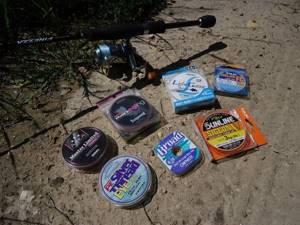
In addition to Japanese spinning rods, you can quite calmly and without damage to the sensations also fish with American-type spinning rods, the same Talon with the lowest lower test indicators. The only thing is that Talon spinning rods will not allow you to send a Cheburashka weighing 2 g closer to the fairway when using the thinnest 0.3 size PE cord. Japanese sticks, due to their structure, allow this without problems. The Avid spinning rod up to 17 g in size 8’6” is close to the Japanese indicators. Thanks to its noodle quality, it does not tear thin lines during hard casts, and does not drain the fish.
Let me digress from the topic and say a little about how to store kits on the river bank, especially if you have several of them. Night fishing for pike perch involves stationary fishing, rarely when we move ten to two meters relative to the starting point. Having found the point, we catch the moment of exit. Everything unnecessary - food, water, if the night is warm, then we leave things on the shore, hanging them in the trees and laying them out on a bed of polyethylene or light fabric. We leave on a vest and a long-sleeved sweater to protect against mosquitoes and midges, which bite even at midnight. Where should I put the second spinning rod? You can carry a special stand with you, which is extremely convenient, but this is if you come by car. In all other cases, it is convenient to use a specially prepared stand, which we stick on the shore and place a second spinning rod on it. The only thing is to make sure that the cord and the tip of the spinning rod are not near the paths and do not stick out in your direction. At night, while fishing for pike perch, you can easily run into an unexpected tulip of the rod or get tangled in the cord with a working spinning rod; unnecessary problems are of no use at night. Therefore, place the spare rod as vertically as possible, next to your things, so that only you know the approach to it.
A little about the cord.
Thin and thick, flat and round, dull and voiced... There are so many of them in our world today that it is extremely difficult to choose the right one. I use the time-tested Sunline super PE, Varivas of various series. The thinner the cord, the better, but do not try to set up a web that can only catch bleaks or roaches. The night pike perch is strength and power in one person, it doesn’t understand jokes, and it doesn’t care about your “wait, I’ll pump you up and take you.” From a night flashlight or whatever you use. God forbid it sees the light of day, it tears so much that sometimes it cannot withstand a serious jig line No. 1 according to the Japanese classification. Unwinding - as always, no less than 150 meters, no one knows what will fly in on the next Tuk in the pitch darkness. Remember about catfish? Remember always when fishing at night.

Whether there will be color markings on the cord or not is not the point, but cords that transmit impulses very poorly when tapped on a hard bottom are immediately thrown aside. An example of such a cord is Unitika Silver Thread EYE Catch. Having a reeling length of 150 meters, a bright yellow color, and a rather pleasant structure to the touch, it is literally useless when fishing with a jig; it suppresses touching the bottom at once. Use only those cords at night that have proven themselves reliable during the day. Nothing else is required from the cord.
Search for places.
The most important thing in night fishing for pike perch. From my own experience, I will say that it is difficult to find stable operating currents; you have to devote more than one fishing trip to the search, remaining after a whole day of fishing until it gets dark, and it is possible that a couple of zanders that hit will remain a couple of zanders. At the same time, a large seasoned pike perch can actively feed a little higher or lower. You can find the place where pike perch daily forays based on three signs: the presence of small fish after sunset at the intended fishing point, the presence of a small current, and a hard bottom. Looking for pike perch on the mud is a stupid task; more likely a pike will strike there, which we don’t need at all, since we fish without a leash. And again, the presence of three factors at one point is not a sign that when darkness falls, all the pike perch that are in the river will immediately run aground and begin to actively attack the bait. Sometimes incidents happen when a seemingly unremarkable place brings one bite after another, but an interesting, clearly pike-perch place remains silent for a day, two, three... To narrow down the search area a little, you need to calmly fish sections of the river one by one during the day, and discover the presence of pike-perch in during the daytime, somehow mark this place so that you can fish it very carefully at night. A pike perch, feasting during the day on some ridge or riffle, will at night attract more than one flock of relatives, probably many times larger than itself. Naturally, it will no longer be there, since a 3 kg pike perch can easily dine on its relative weighing 200 g, but we only need small pike perch to find a place. River riffles that are visible during the day work perfectly, where the water is divided into several visible streams, there are return lines, and the best thing when fishing at night is to get right into the beginning of such turns. There are a lot of snags in such places, but you need to come to terms with them by calculating during the day at what position of the spinning rod and at what distance from the shore they often occur. At night, all this happens automatically.
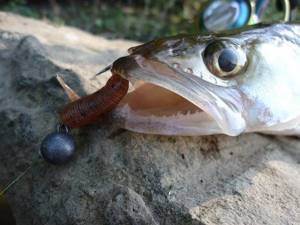
Sand spits always work, the main thing is to choose the right one. It should differ from similar ones by a sharper slope, have a small hole behind it, from which the pike perch flies out when chasing the fry, small bushes of grass are desirable. Such areas are not always located in areas of mass bathing; is there a lot of sand deposits among the overgrown shores? My Oka is almost all like this, so it’s not difficult to find the right place, but it’s more difficult to find pike perch there. If you managed to detect the presence of pike perch everywhere, then you are very lucky - the main thing is to understand that these outlets are stable every day, and not to give up your place to anyone. At night, it’s generally better to fish with a maximum of two people, without interfering with each other. By constantly moving along the riffle, we can easily scare away the pike perch, and it will not be at this point until the next evening. Is it necessary, having found a point with such efforts, to screw it up?
An interesting place will be the lunar path, running from the water's edge to the opposite shore, and only we can see it as a path; under water, the moonlight illuminates everything and everyone who dived in the river at night will understand.
